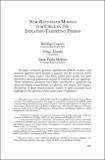| dc.contributor.author | Caputo, Rodrigo | |
| dc.contributor.author | Liendo V., Felipe | |
| dc.contributor.author | Medina, Juan Pablo | |
| dc.coverage.spatial | CHILE | es_ES |
| dc.date.accessioned | 2019-11-01T00:03:32Z | |
| dc.date.available | 2019-11-01T00:03:32Z | |
| dc.date.issued | 2007 | |
| dc.identifier.isbn | 978-956-7421-28-2 | |
| dc.identifier.uri | https://hdl.handle.net/20.500.12580/3729 | |
| dc.description | Dynamic stochastic general equilibrium (DSGE) models with nominal rigidities have become a popular tool for monetary policy analysis in recent years. The basic sticky price model has been enriched to include additional sources of nominal and real rigidities. These additional elements have been introduced to generate the observed degree of persistence in inflation, real wages, and output. Extensions of these closed economy models to open economies have highlighted the presence of the same types of rigidities. | |
| dc.format | .pdf | |
| dc.format.extent | Sección o Parte de un Documento | |
| dc.format.medium | p. 507-546 | |
| dc.language.iso | eng | |
| dc.publisher | Banco Central de Chile | |
| dc.relation.ispartof | Series on Central Banking, Analysis, and Economic Policies, no. 11 | |
| dc.rights | Attribution-NonCommercial-NoDerivs 3.0 Chile | * |
| dc.rights.uri | http://creativecommons.org/licenses/by-nc-nd/3.0/cl/ | * |
| dc.subject | INFLACIÓN | es_ES |
| dc.subject | ECONOMÍA KEYNESIANA | es_ES |
| dc.subject | MODELOS ESTOCÁSTICOS | es_ES |
| dc.subject | ECONOMÍA KEYNESIANA | es_ES |
| dc.title | New keynesian models for Chile in the inflation-targeting period | |
| dc.type.doc | Artículo | |
| dc.file.name | BCCh-sbc-v11-p507_546 | |


